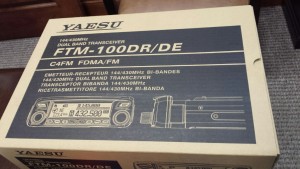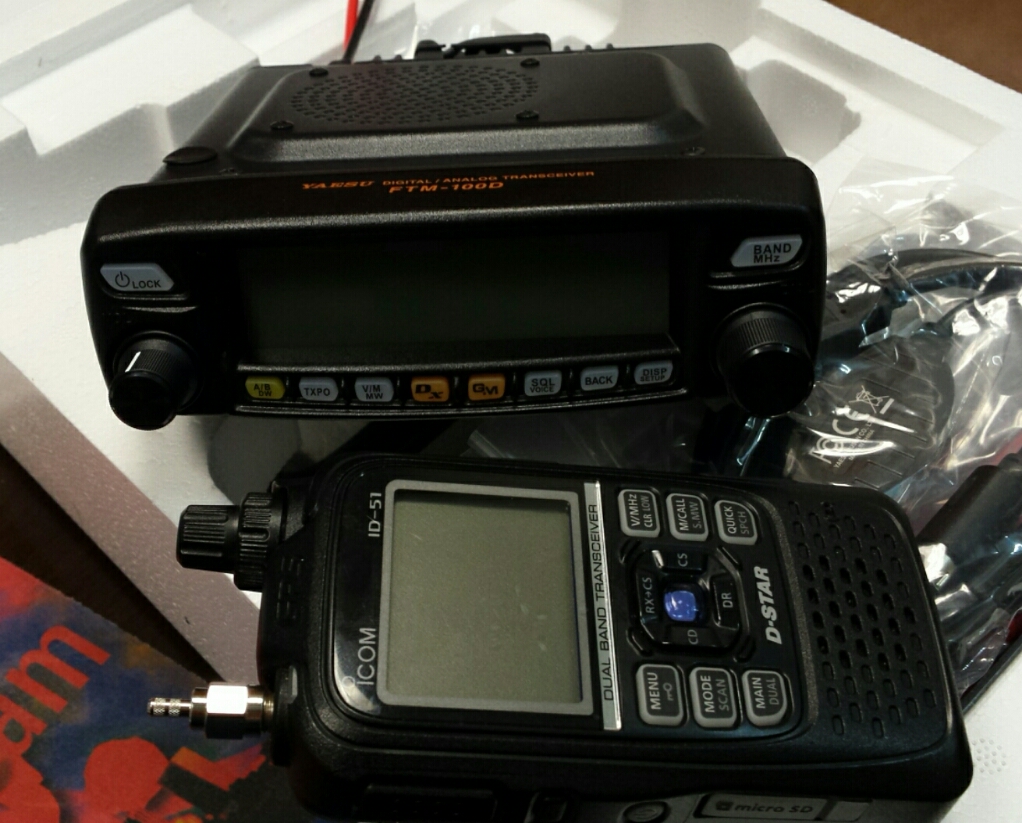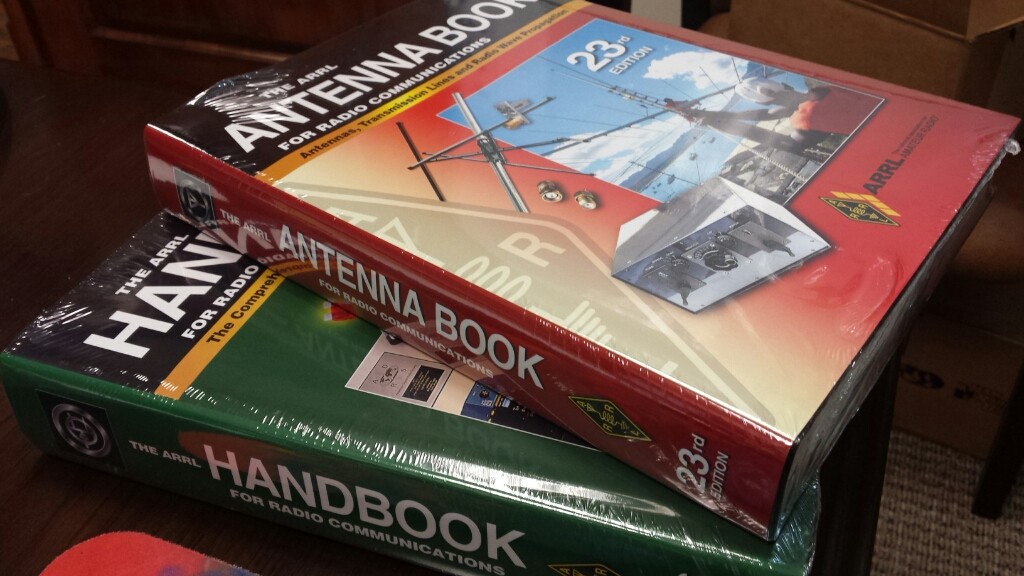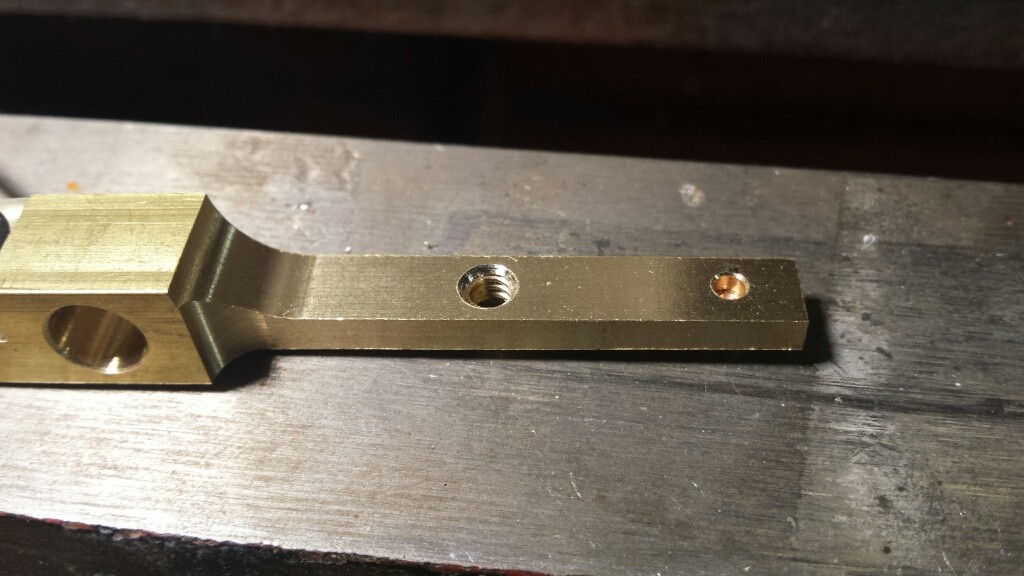I did not expect it to be large, but it is even smaller than I expected. Mounting it may thus prove easier as well.
Oh, That Explains It….
On my commute this morning, I could not help but notice that the .33 repeater was very quiet. When I got to work and was gathering my stuff to go in the office, I think I found the problem:
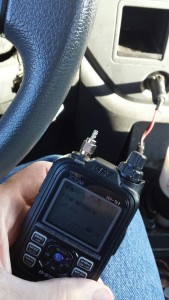
Yep, that’ll do it.
I use an SMA to PL259 cable to connect the output of the handheld to the input of a Mirage BD35, but that is the third cable I’ve had on the radio in only a few months. They just don’t hold up. They don’t appear to be suitable in an application where it gets moved around a lot and are disconnected and reconnected a few times a day.
All the more reason I am so happy to see this notification in my email this morning 🙂
North American QSO Party
Today was my first non-Field Day contest, the NAQP.
Total Contacts = 83
Total Points = 3,569
Operating Period: 2016/01/16 19:02 – 2016/01/17 05:42
Total Contacts by Band and Mode:
Band CW Phone Dig Total %
—- — —– — —– —
40 0 46 0 46 55
20 0 33 0 33 40
15 0 4 0 4 5
— —– — —– —
Total 0 83 0 83 100
The Icom, of course, suffered it’s transmit weirdness and delayed my start. I pulled the cover off and tapped around on the main board unit it started working and it kept working all day. Maybe that magic will last beyond today.
I worked in the comfort of the dining room, via RemoteRig.

Last Field Day, the RemoteRig would sometimes disconnect from the WLAN. I never really found out why, I just rebooted the Control-RRC. Today, however, no issues. Then again, it was only 30 feet from the router.
CI-V and Code Warrior Update
I did a bit of work trying to get CI-V up with RemoteRig. In the Radio Settings page, there is a pulldown menu for Program Mode. Option 1 is Icom CI-V and Option 2 is IC-7100, IC-706, IC-703. This implies that I can run either CI-V or control head, not both. I will need to dig into it a little deeper. The power of being able to choose either the control head or the laptop/cellphone option would be *greatly* enhanced if I didn’t have to choose before I left town. I know that the comm ports can be set up to carry other data, such as rotator control, while the control head is operational. I presume that CI-V can also be set up thusly. It will take a little experimenting with the laptop and both RemoteRig devices on the bench.
Meanwhile, I got some brass hardware and made the contact blocks on the Code Warrior better.
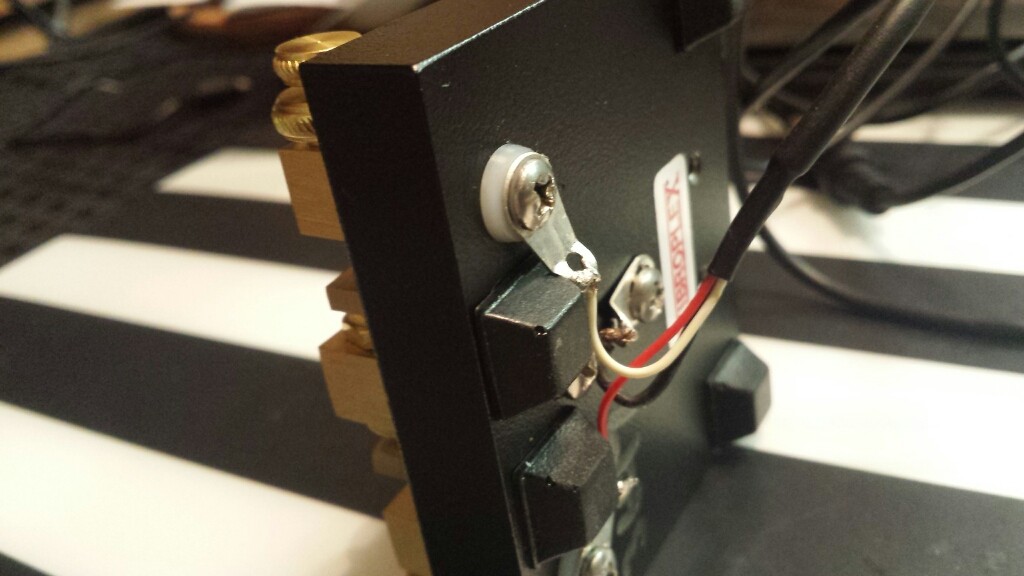
This is the stock stainless steel hardware, a screw directly in the contact block and through the wire lug. Note that the wire lug would rather stay with the screw than with the nylon insulator. With three or more hands, I could hold the lug and the block while tightening the screw, but I’m picky that way.
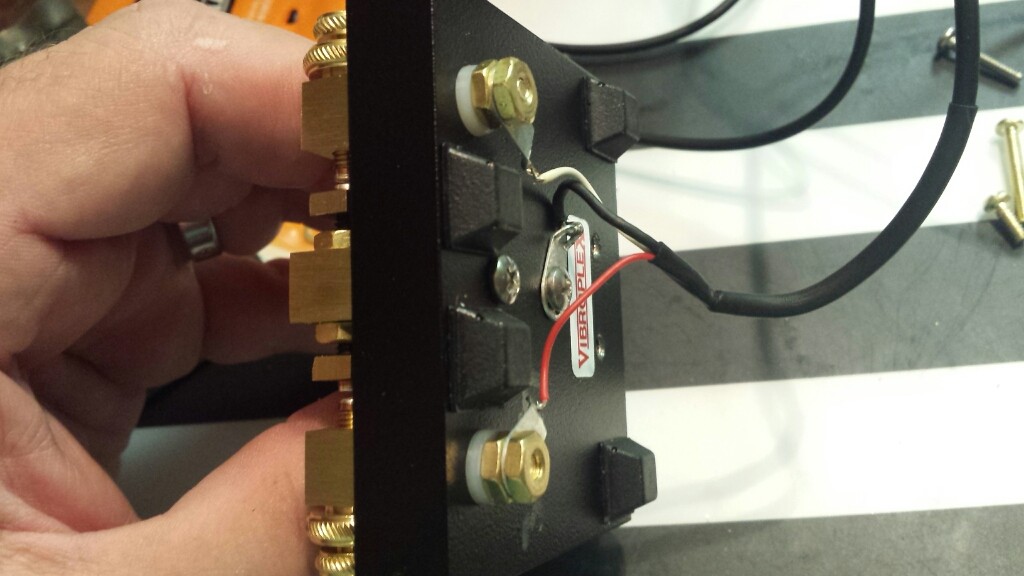
After, the block is held by the first nut and the wiring by the second. As expected, the new assembly is taller than the rubber feet, so I will have to get some taller ones to fix that. I did have the proper application of flat washers, but the entire assembly was even taller, making the rubber feet problem worse.
There is still one more minor improvement needed for it to be called finished, namely to fill the hole though the base so that the blocks only go in one place.
RemoteRig and CI-V
First, let me say that, although I have made all the physical connections, I have not yet configured RemoteRig for use with the Code Warrior paddles. Free time has not yet manifested in the proper form 🙂
I will actually have a couple of related projects to complete, all of which is intended to make HF operating easier, and maybe I can get them all done at the same time.
CI-V is what Icom calls their protocol for computer controlling their products. It is an initialism for Communications Interface V (as in 5). There was/is a CI-IV, implemented most notably in the IC-751 transceiver, but almost every transceiver and receiver since then offers connectivity via CI-V. The two are not electrically interchangable, but there exists a CI-IV to CI-V converter and CI-V has backward compatibility with the data protocol of CI-IV.
Fundamentally, CI-V is a multidrop half duplex serial data protocol and command set. Electrically, it is a single wire for transmitting and receiving data and a ground or return, with logic levels of 0v and 5v. Bitwise, the protocol is compatible with a (once standard) PC serial port, though it must use a level conversion chip. RS/EIA-232 is a +/- 12v protocol. Also, since transmit and receive are shared on a single wire, a diode or some such needs to be in line to isolate the transmitter output of each device on the line from the other devices.
Most or all that is taken care of for us in the Icom CI-17 interface or it’s compatible clones.
There are two common cables. One has a USB serial port and all the necessary wiring and drivers needed to connect a PC or laptop directly to the transceiver. The other is a DB-9 serial to CI-V cable which has the level conversion circuitry built in. Since the RemoteRig implements a DB-9 serial port from one end to the other, it is this cable that I need and have indeed procured.
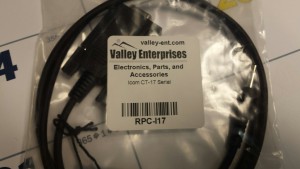
There are two main reasons I want to implement CI-V in my setup.
One of the handiest things logging software can do is automatically log your frequency and mode, which it can do by knowing what your rig is currently running, via computer control. Because RemoteRig inserts a configurable bit of hardware in the middle of that chain, I may need to dink with it a bit to get it operational, but I should be able to plug my laptop into the Control-RRC and use the CI-V protocol to talk through the LAN/WAN to the Radio-RRC and on to the physical radio. Not only can that help in logging, but I can also do other rig control functions.
The other big thing is RemoteRig’s alternate control clients.
RRC-Micro PC-Client is a small hardware device that lets your PC do remote rig control over WAN/LAN while it takes care of the SIP audio streams and PTT. Operating thusly, you can leave the comparatively bulky Control-RRC, radio control head and speaker at home and work completely from a laptop, say from a hotel room while travelling for business.
If your laptop is too big, try using your Android telephone or tablet and the RRC-Nano App. It implements a light version of rig control (with brand-specific versions of the app) and the Android device does the audio, too.
In the case of the IC-706mkIIg, the CI-V implementation in that model (and others) doesn’t doesn’t support power on/off. To prepare the radio for remote operation with either of those clients, put the control head back on the radio and leave it powered up. When either client connects, the radio will respond to CI-V controls and the Radio-RRC takes care of the remote communications and audio.
That’s the design, anyway.
Shipping Weight 18lbs
Minimal Tweaking and Some Updates
I was able to do some really minimal tweaking to make a pretty big difference in the feel of the Code Warrior Jr.
First (and I failed to snap a pic of this), measured the dit bar and it’s bearing. I found that the length of the bearing was about 0.005mm shorter than bar. I ground (by hand, on a diamond knife sharpening stone) the bottom face of the bar shorter. It took two grind-fit passes to get the height just right, where I could tighten the screw all the way without the bar binding.
There was still a tiny bit of radial play, but the two bars are about the same now.
I also cut shallow countersinks into each arm for the magnetic spring screws.
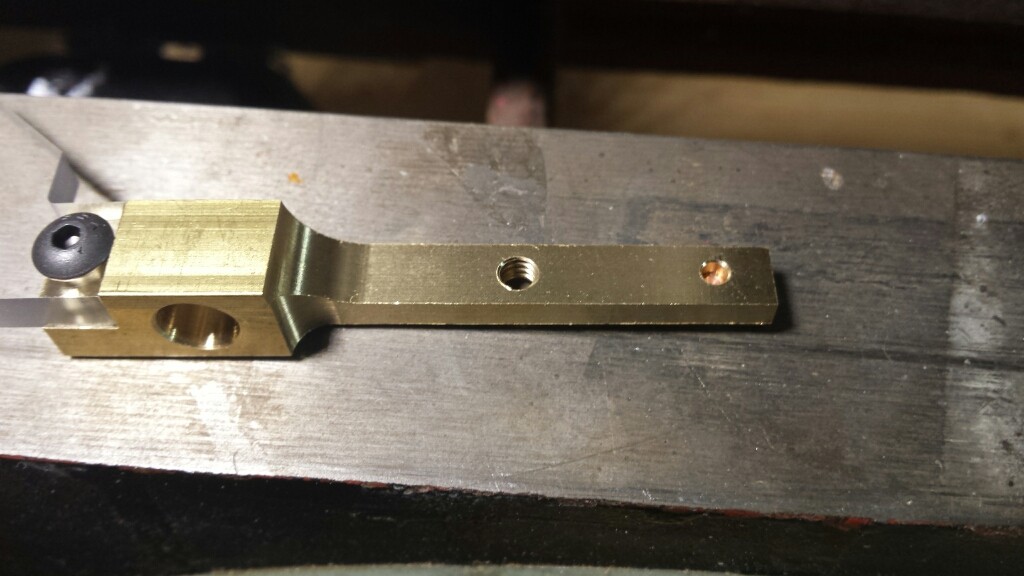
Not bad for hand cut, I suppose.
Now the screw head can be adjusted far enough to greatly lighten the tension on the paddle.
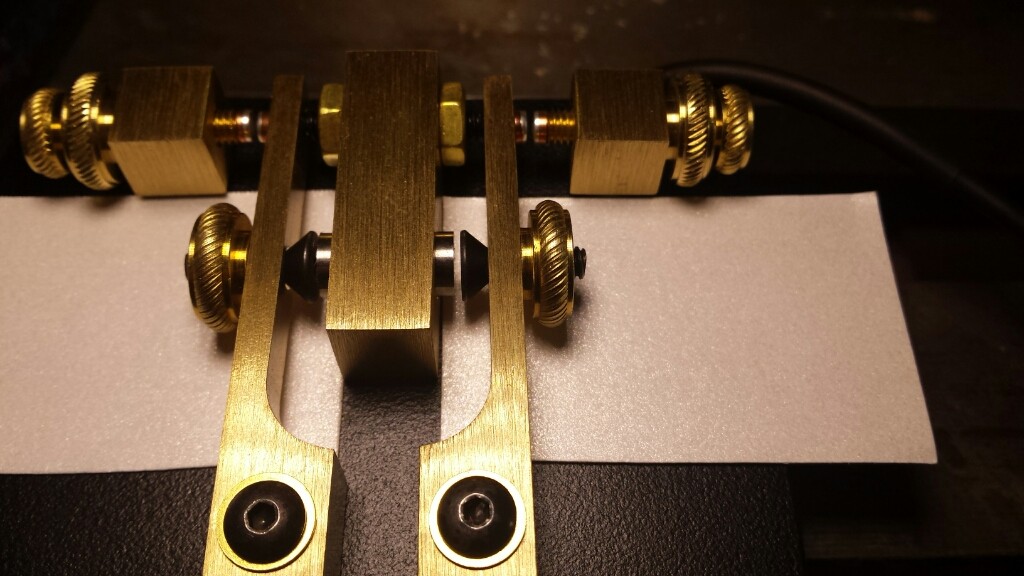
I also chamfered the edges of the acrylic paddles just a little bit, enough to take the edge off.
For now, I choose to ignore the contact block mounting issue. I will gather some hardware to fix that better. Besides using a bit of threaded rod to secure the mounting better, I think I will also put some sort of spacer inside the mounting holes in the base to stabilize them horizontally. I’m sure I will need to adjust the resting stops once that is done.
Here is my actual unit, ready to use for now.

In other news, Ham Radio Outlet indeed made the cable thing good and it will cost me nothing. Good guys there in Plano.
I got my Gordon West Morse Code course CDs yesterday and listened to a bit of Disk 1 on the way home from work today. Since you need to write down what you copy, it may not be something I can do much of on the commute.
Code Warrior Jr Paddle
I wired and tested my CWJR last night. I found it to be solid and fairly well designed, but not particularly well fitted and assembled.
It was indeed ready to use as supplied, adjusted reasonably well. However, in order to connect my wiring to it, I had to remove the screw that holds down each contact block and that revealed a lot of loose tolerances.
I got it back together and fooled with it for a while. It’s been many years, so it will take a little time to get my iambic fist back. Or any fist, really.
I got online to see if there were any mods people have done to address the issues I found with it. There are a few, mostly within the text of reviews on eham.net. Wow. Some people have had bad troubles with theirs. Most cite simple but numerous QC issues out of the box:
“Looks deceptively well built until you attempt to adjust it.”
“You basically need to take the whole thing apart, guess at a setting, then put it back together to test it.”
“The instructions say that most people will not need to adjust anything. My foot!”
Once I effect the tweaks and repairs that I feel I must do, I will offer my review as well. Overall, I would say that it is a bit like the Hubble telescope mirror was originally, a precise machine built to the sloppy specs.
The worst problem I was dealing with is that the contact blocks are secured thusly:
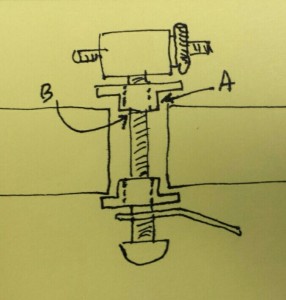
The drawing is not to any scale, but should illustrate. The assembly has two likely cost-cutting measures that hurt the quality of the design while helping to make it inexpensive to purchase.
The nylon shoulder washers are not sized well to either the holes in the device’s base nor the screws that pass through them. If the outside diameter indicated by “A” were larger (or the hole in the base smaller) and the inside diameter indicated by “B” were smaller, the fit would be much better.
The second issue is more of a preference item, but I would prefer if instead of a screw, there was a threaded rod of the proper length. First, the supplied screw is really only barely long enough and I presume the next longer one would probably be too long. However, with a longer piece of threaded rod, the contact could be secured tightly with a nut, then a second nut could be used to secure the wiring lug and the entire assembly trimmed to the perfect length. As it is, tightening the screw to hold down the contact block rotates the wire lug under it because it turns so easily against the slippery nylon and the screw is too short to add the washer that might prevent that. It’s hard to get the screw tight enough to firmly secure the block without turning the wire lug too far.
These changes may also necessitate mounting taller feet on the base but I will cross that bridge when I come to it.
Solid and consistently mounted contact blocks will reduce the remaining problems to nitpicking. I like the feel of the magnetic return and it is certainly compact. However, with the generally loose tolerances, I found that on my unit, the tension on the dit paddle (righthand paddle) cannot be reduced because the adjustment screw is as far into the arm as it can go. In fact, out of the box, the adjuster screw was touching the magnet at rest, making it quite stiff. The center block, which holds the magnets and the resting stops, is secured with two screws, one of which is shared with the common wire connector and is thus subject to moving around whenever the wiring is changed. This seems to be what caused the dit paddle to stick to the magnet. I was able to scoot the block over and adjust the screw enough to stop the sticking, but I can’t get it far enough away to lighten the tension as much as I’d prefer.
The tension adjustment screw has a countersink head, but the threaded hole in the paddle arm is not drilled with a countersink. By the design, it may not really be necessary, but with the fit of my unit, I think it would solve the problem to countersink that hole at least a little bit. This will allow the screw head to be adjusted farther from the magnet, thus decreasing the tension on that arm. As I do a bit of unrelated metal work that involves countersink drilled holes, I have the tools and this will be a trivial fix.
While we’re on the subject of the paddle arms, a common reviewer complaint is vertical play on the pivots. While the reviewers say the issue is vertical play, what it really looks like to me is slightly loose tolerances on pivots, which gives some radial play. This manifests itself as the contact end of the paddle having a lot of vertical play. Maybe that’s a distinction without a difference, but it does affect what needs to be done to address it.
Again, you should not be too critical of my Post-It mechanical drawing:
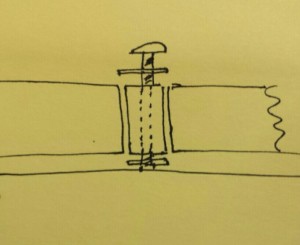
The paddle arm pivots are probably about as well designed and built as one could hope for without the added expense of hand fitting. Shown here is the arm, a bronze sleeve bearing sized to fit in the hole of the arm and the screw and washers to space and secure the assembly to the base.
On my unit, the dit paddle is a little bit loose. It has both vertical play, where it slides up and down on the pivot, and radial play, where the contact end can swing up and down, albeit in a very small arc. It is not loose enough to prevent it from working and I’m not totally convinced that it must be fixed. The movement is, however, different from the dah paddle, so it would be better if they were more consistent. At first, I thought I could simply tighten the screw a little to take up the play, but tight enough to take of the play is also tight enough to drag the return, resulting in a stuck key and continuous dits. A tiny bit looser and the play is back *and* the screw is loose enough to loosen with use.
I think the solution will be a washer that is smaller than the hole in the paddle so that the screw can be tightened down securely against the bronze bearing and another washer large enough to engage with the top of the paddle arm but thin enough to not cause drag. A washer that is too thick can be easily sanded or filed thinner. This is the essence of hand fitting. It takes expensive labor to do such fitting and *not* doing it keeps the cost of the product lower.
One way to do that is to introduce a shim, often aluminum foil, between the arm and the bearing or the bearing and the screw, or maybe both. This is probably fine, though aluminum foil is pretty soft and may need occasional replacement.
An arguably better solution might be to hand fit the bearing to the hole in the paddle arm. I would do that in this case by first lightly stippling the surface of bearing. Stippling is a way to tighten the fit of moving parts. It used to be a common method of tightening loose machinery long ago, particularly in hand fitting gun parts. Similar to knurling valve guides in an engine, stippling is more suited to hand tools. Using a sharp punch, you place indentations over the surface. As the point of the punch penetrates the metal, it displaces a volume of metal away from the point and this material flows away and upward from the point. This gives the bearing high spots everywhere there is a punchmark. Lap those back down but not all the way to the mean surface and you end up with a bearing that is overall larger diameter than the mean, and thus a tighter fit. Since there is no great mechanical stress on this bearing, I will probably put a ring of punches evenly spaced around the bearing, near the ends. It is the ends of the bearing that needs to fit tighter to fix the radial play issue. Punching and fitting one end first will probably be easier, too.
Stippling could also help fit the vertical play by stippling the ends of the bearing, making it slightly longer. This would be a fairly delicate operation considering the surface area on the ends of the bearing, but it would be no washer to add and sand thinner. I will consider it.
Talk about nitpicking, I personally would prefer it if the contacts operated quietly. The contact click and the return to rest click are noisy. The contact click would be pretty hard to silence, short of wetting the contacts with mercury, but I may put a thin pad of some material under the resting points on the arms to muffle the return to rest click. Anything to prevent a metal-on-metal impact should tone it down a bit.
The last compaint I have about the paddle I have already mentioned and that is the acrylic paddles themselves. They are presumably laser cut, so they are of precise dimensions but the edges are uncomfortably sharp against the fingers. A little sanding would probably address it, but I will probably make some replacements, likely from wood.
The eham reviews indicated that these paddles are also pretty delicate. At least one complains that one broke while operating portable limiting the operator to dit-less Morse code, “Guess it’s o.k., if your name is Tom and you are talking to your mom about the sounds cows make.” Another indicated that the paddle was cracked upon unboxing.
In short, it seems that the Code Warrior Jr iambic paddle set has great potential as a small sturdy keyer, but that some units are imperfect upon delivery. Whether that is a factory issue or a distribution and retail issue is hard to say for sure, but I am confident that after just a little tweaking, it will turn out to be a fine instrument that will certainly outperform my meager Morse code talents.
Santa’s Little Online Sellers and “Why Morse Code?”
I have picked up a few things ham related lately, nothing earth-shattering, but all contribute to my overall joy.
I got a greatly upgraded mobile antenna, a Comet SBB-7NMO. Comet’s website is not particularly friendly to highlighting one particular item, but the SBB-7NMO is a 2m/70cm mobile antenna. In 2m, it is a 4.5dBi gain 6/8 wave center-loaded vertical and in 70cm, it’s three stacked phased 5/8 waves for 7.2dBi gain. That’s not that much less than my 10 foot tall Diamond base antenna. With it on a magnetic base stuck on the roof of my truck, I was able to hit two of the three Decatur repeaters from downtown Fort Worth, about 40 miles, with 5W from an ID-51. Yep, 40 miles on an HT, from street level surrounded by tall buildings. I will continue testing.
I also got a replacement adapter/jumper to connect that ID-51 to my mobile amplifier. The one I have now has developed a poor connection in or near the SMA end. Most likely, it came from being yanked on when the cable snags on something while lifting the radio up to use it. The new 6 foot long one will be less subject to this shock as it will be long enough to allow me to move the amplifier to a better spot behind the seat.
Actually, I ordered two of these cables, but one of them arrived, properly labeled from the manufacturer, but with the wrong cable in the package. I am confident HRO will make it right.
I also got a copy of the ARRL Operating Manual, which I have wanted for a long time but finally ordered it. When I studying to get my license back, I found there were a lot of modes and operational procedures that didn’t even exist when I had my previous license. More on that later.
In a starburst of extreme irony, I traded off a nice set of Vibroplex paddles and then, almost immediately, decided I would like to get back into Morse code and was thus forced to buy a set of Vibroplex paddles. To the outside observer, it might look like I decided to go with a smaller, more portable set to include in my RemoteRig bag. Yeah, let’s go with that for now…
I haven’t suffered from any guilt over my no-code license. I studied hard and in a way that wasn’t just memorizing the questions. I took and passed the Technician, General and Extra tests in one sitting. I understand how operators who earned their licenses before 2007 might lament that Morse code proficiency is no longer required to get a license. One particular friend passed his 20 wpm code test, but was not ready for the written test until after February, 2007, at which time his hard won code element certificate was no longer needed.
The old timers can sometimes make it seem that they consider us, as a class of licensee anyway, to be a lesser hams. Most often, the argument comes across as “back in our day” and “these kids today have it too easy” with a little “get off my lawn” seeping through. They grouse about how all a ham has to do now is be good at taking a test, a test for which you can literally memorize most of the answers and guess the rest.
However, in listening to some local repeater conversations recently, one particular explanation crystallized the real issue for me and it’s one I can definitely identify in myself. Whether it was intended to do so or not, the Morse code proficiency requirement of old allowed hams to become more rounded and experienced operators during the time it took to become proficient in the next higher Morse code speed requirement.
I think was a fairly well rounded Novice by the time I got my Technician ticket. That was 7 years of admittedly intermittent operating during which I operated CW (slowly and not very well) on HF because that’s all I had available to me on HF. I participated in club Field Days. I went to swap meets. I learned how a Teletype Model 28 works. I wrote Morse code sending software for the Commodore 64 and tried to make receive work with a home brew LM-567 board. Once Novices and Technicians were granted some phone privileges on 10 meters, I tried a bit of that, but our rented duplex wasn’t very well suited to putting a dipole up high enough to work well and thus 10 meters was good for little more than chatting around the neighborhood, or would have been if I’d had some ham neighbors on 10 meters.
Once I had that Technician ticket, I was on VHF FM and packet a lot, toyed with microwaves a little and made more antennas, some of which mostly worked. I continued studying Morse code and tried to get my speed up but I couldn’t seem to get over that 10 wpm plateau. That may have contributed to cooling on the hobby.
Fast forward to 2011, more than a decade after I had participated so little in the hobby that my license had expired, and all I needed to do to get it back with the maximum privileges available to any US ham was answer a bunch of multiple choice questions about rules, electronics and radio theory. So here I am, an Extra class licensee with the 20-years-stale experience level of a Technician.
Ok, I get it now.
So, I mentioned the new paddles. I truly did get interested in Morse code again almost immediately after trading off the other paddles. I suppose it was because it was a subject under much discussion at the time. I also found that there are a lot of contests that award weighted points for CW, if you are into that. But all that was before the epiphany about “earning” my class rather than just passing the test for it. Now I’m determined to be a better operator and I think that includes proficiency in Morse code. So I ordered two Gordon West Morse code courses, the 0-5 wpm and the 5-16 wpm courses. I hope that I have forgotten enough Morse code to not be encumbered by old bad habits.
The Code Warrior Jr is equipped with classy looking paddles made of what appears to be clear acrylic sheet. As supplied, the edges of these paddles are fairly sharp. It looks great, but is not very comfortable to the touch.
I will either replace or modify these, sooner or later. I am a woodworker as well and I have a fair bit of African blackwood or mesquite that would look great there. At the very least, I can take the bitey edges off the plastic.
I will wire it with a standard 3.5mm plug. Natively, the paddle input to the RemoteRig takes that connector. I will be able to use an also standard 3.5mm to 1/4″ headphone adapter to allow me to plug it directly into my IC-706mkIIg, but I’ll need an external keyer for the Kenwood. I might also wire an adapter to let me plug it into the IC-706’s mic jack. In CW mode, the mic up and down buttons can be reassigned as dit and dah inputs for the built in keyer and the manual shows how to connect external paddles for this. Icom cleverly uses a resistor in series with each paddle switch to detect dit, dah or a squeeze for both with a single input and ground.

By this connection, I can use the IC-706’s head on the separation cable without having to run the paddles all the way to the back of the rig. This would most likely come up only in certain operational situations, such as Field Day in the camper where I might not want to run the antenna, ground and power all the way up on to the little table that I will doubtlessly be operating from.
RemoteRig CW operation looks to be pretty well thought out, if a little weird. The Control end can accept either a straight key or, with its built in iambic keyer, a paddle. The problem they must solve is that CW keying is a pretty much real time immediate thing, but the key and the actual radio are separated by a potentially jittery and latency delayed LAN/WAN. RemoteRig uses a couple of settings to let your CW string be sent over the network and reconstructed on the fly at the radio end and thus transmit nice readable code. Working on the LAN at home, jitter and latency will be minimal, or at least I expect it to be consistent.
Lost A Bit of The Shine
Well, my Diamond X300A reaches out there, but only if the radio is working. Intermittently, the IC-706MKIIG fails to transmit on 2m or 70cm. The power output meter bounces momentarily to full power then back down to about 20-30%. It looks like the sort of thing the rig will do into a bad load, but I can verify with two other rigs (Icom ID-51 and Kenwood TM-731A) that the antenna is good.
On a mods webpage, there is mention of a fix for a problem specifically with FM transmit that is very similar to what I am experiencing. The fix is basically reflowing the solder on an adjustable capacitor. The next time the symptom shows, I will try to remember to look at FM on HF to see if it happens there as well as SSB on 2m or 70cm.
My gut feeling has been that its something in the power amp to antenna connection chain. Once I have the box open, I will look at both.
